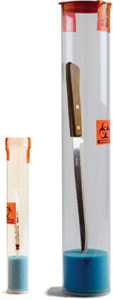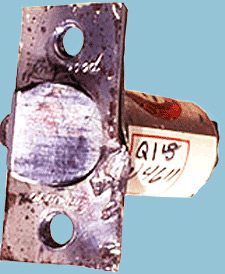Home | Glossary | Resources | Help | Contact Us | Course Map
Archival Notice
This is an archive page that is no longer being updated. It may contain outdated information and links may no longer function as originally intended.
Related Evidence
Objects with bullet holes present, such as bedding, upholstery, sections of drywall, rugs, curtains, clothing, etc., should be collected, marked, and packaged for microscopic and chemical testing. Residue-bearing evidence items should be packaged individually. Unused paper bags or wrapping paper can be used for smaller items.
Direct marking of clothing items should be inconspicuous, such as on the inside of the waistband of trousers or inside the rear shirt collar or shirttail. Avoid marking in any area where gunshot residue may be found.
Larger containers are required for large items, such as car seats, upholstered chairs, rugs, sections of drywall, curtains, bedding, etc. Marking requirements remain the same; any area where gunshot residue is suspected should be protected.
Special care should be taken to air dry (out of direct sunlight) any blood-soaked items. This minimizes decomposition and exposure to ultraviolet light, which can degrade DNA.
Toolmark Evidence
Investigations involving tools and toolmarks cover a broad spectrum of crime scenes and materials. Therefore, toolmark evidence collection requires various techniques. A tool is defined as any item that is used for mechanical advantage. The actual tool used during the commission of a crime may not be obvious. For example, a butter knife is considered a tool when used to pry open a drawer during a burglary. Toolmarked items are any objects marked by the use of a tool(s).
Tools
The operating surfaces of suspect tools should be protected and preserved. The tool should be individually packaged and identified with a string tag bearing the information required by agency crime scene search protocols. If agency protocols mandate the direct marking of evidence, the required information should be scribed in an area away from the operating surface of the tool.
Tool evidence should be sealed in a strong, secure container. If a tool is a sharp, especially a potentially body fluid-contaminated sharp, it should be packaged in a leak proof, puncture-resistant, sealed container. Precautions taken during packaging help to prevent the introduction of contaminated sources of trace material.
Toolmarked Items
Although toolmarked items come in many shapes and sizes, most can be easily collected, marked, and documented. Some toolmarked items require different collection methods. For example, a banks massive safe door cannot be removed.
Small toolmark evidence items may include
- cut alarm wires,
- lock shackles,
- entryway doorknobs,
- telephone lines,
- sections of power transmission lines,
- links from a chain link fence.
The questioned (evidence) toolmarks should be protected. These items should be wrapped in heavy paper to avoid damaging the marks or losing trace evidence. A tag or sturdy label containing the required identifying data should be attached at a point well away from the questioned marks.
If it is necessary to remove an item from its source, as is often the case, the location where the evidence was separated from that source should be labeled. If this is not done, there is the likelihood of doubling the work of the toolmark examiner, particularly in the case of wires, power lines, and chain links. For example, submitted unlabeled wires would require the examination of both ends; properly labeled wires would require only the examination of the labeled end. The questioned items should also be well protected from contact with the suspect tools.
A large, freestanding floor safe is a classic example of a large toolmark evidence item that is difficult, but not impossible, to move. Because of the special handling requirements and shipping expense necessary to protect toolmarks on large items, they are frequently delivered to the laboratory on a pallet.
Permission may be required to cut out any microscopic marks of value. Depending on laboratory policy, the examiner may need to contact the investigator to acquire permission. If the microscopic marks cannot be cut out, casting material must be used to preserve them for comparison purposes.
Large immovable objects or objects that cannot be taken out of service must be initially examined on-site for trace evidence and a cast made of the marks for later comparison at the laboratory. Agency policy would dictate whether investigators, crime scene technicians, or laboratory examiners go to the site to make the casts. As always, trace evidence and the careful marking and packaging of the casts are critical concerns. As the cast is hardening, it is convenient to insert the identifying information in the casting material.
Additional Online Courses
- What Every First Responding Officer Should Know About DNA Evidence
- Collecting DNA Evidence at Property Crime Scenes
- DNA – A Prosecutor’s Practice Notebook
- Crime Scene and DNA Basics
- Laboratory Safety Programs
- DNA Amplification
- Population Genetics and Statistics
- Non-STR DNA Markers: SNPs, Y-STRs, LCN and mtDNA
- Firearms Examiner Training
- Forensic DNA Education for Law Enforcement Decisionmakers
- What Every Investigator and Evidence Technician Should Know About DNA Evidence
- Principles of Forensic DNA for Officers of the Court
- Law 101: Legal Guide for the Forensic Expert
- Laboratory Orientation and Testing of Body Fluids and Tissues
- DNA Extraction and Quantitation
- STR Data Analysis and Interpretation
- Communication Skills, Report Writing, and Courtroom Testimony
- Español for Law Enforcement
- Amplified DNA Product Separation for Forensic Analysts



